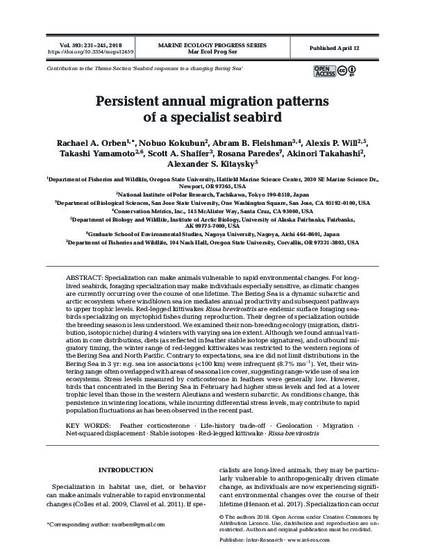
Article
Persistent annual migration patterns of a specialist seabird
Marine Ecology Progress Series
(2018)
Abstract
Specialization can make animals vulnerable to rapid environmental changes. For long-lived seabirds, foraging specialization may make individuals especially sensitive, as climatic changes are currently occurring over the course of one lifetime. The Bering Sea is a dynamic subarctic and arctic ecosystem where windblown sea ice mediates annual productivity and subsequent pathways to upper trophic levels. Red-legged kittiwakes Rissa brevirostris are endemic surface foraging seabirds specializing on myctophid fishes during reproduction. Their degree of specialization outside the breeding season is less understood. We examined their non-breeding ecology (migration, distribution, isotopic niche) during 4 winters with varying sea ice extent. Although we found annual variation in core distributions, diets (as reflected in feather stable isotope signatures), and outbound migratory timing, the winter range of red-legged kittiwakes was restricted to the western regions of the Bering Sea and North Pacific. Contrary to expectations, sea ice did not limit distributions in the Bering Sea in 3 yr: e.g. sea ice associations (<100 km) were infrequent (8.7% mo-1). Yet, their wintering range often overlapped with areas of seasonal ice cover, suggesting range-wide use of sea ice ecosystems. Stress levels measured by corticosterone in feathers were generally low. However, birds that concentrated in the Bering Sea in February had higher stress levels and fed at a lower trophic level than those in the western Aleutians and western subarctic. As conditions change, this persistence in wintering locations, while incurring differential stress levels, may contribute to rapid population fluctuations as has been observed in the recent past.
Keywords
- Feather corticosterone,
- Life-history trade-off,
- Geolocation,
- Migration,
- Net‑squared displacement,
- Stable isotopes,
- Red-legged kittiwake,
- Rissa brevirostris
Disciplines
Publication Date
April 12, 2018
DOI
doi.org/10.3354/meps12459
Publisher Statement
This article was published in Marine Ecology Progress Series, volume 593, 2018, and can also be found online at this link.
© The authors 2018. Open Access under Creative Commons by Attribution Licence. Use, distribution and reproduction are unrestricted. Authors and original publication must be credited.
Citation Information
Orben RA, Kokubun N, Fleishman AB, Will AP and others (2018) Persistent annual migration patterns of a specialist seabird. Mar Ecol Prog Ser 593:231-245. https://doi.org/10.3354/meps12459
Creative Commons license

This work is licensed under a Creative Commons CC_BY International License.
